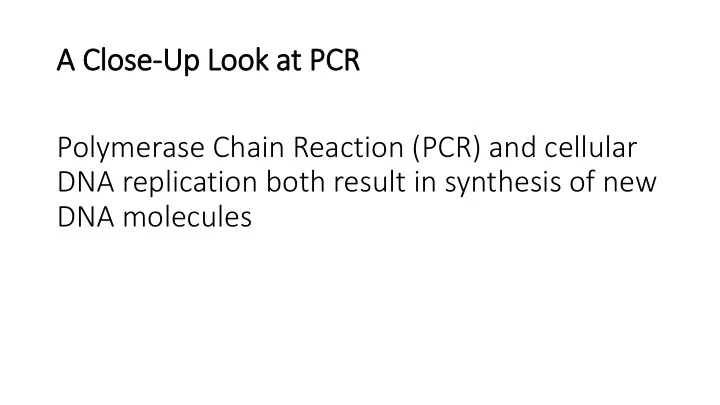

A C Close se-Up L Look ook a at PCR Polymerase Chain Reaction (PCR) and cellular DNA replication both result in synthesis of new DNA molecules
Rev eview ew: DNA NA Rep eplic lication DNA r repl plication i is a semiconser servative process ○ New strands are built from complementary base pairing In a cell, all of the DNA is DNA m must b bec ecome s e sing ngle s e stranded ed i in n order der t to let new ew n nitrogen enous b s bases es bind nd to t the he old s d strand copied during the process of In replication, this occurs via a replication ○ fork DNA replication! Repl eplication only occurs i in n the he 5’ to 3 3’ direc ection The c chemic ical b l bonds i in DNA are a as follo ollows: Phosphodiester bonds in the backbone ○ are strong conservative bonds Bonds between the DNA bases are ○ weaker hydrogen bonds. Image courtesy of Madeline Price Ball, Wikiemedia Commons 2013
During P g PCR m R many c copies o of a a target r reg egion of DN DNA a are s e synthes esized ed
Imp mpor ortan ant V Vocabular ary ● A heat stable version of DNA polymerase, Taq Polymerase , is used to synthesize DNA ● A dynamic, and complex process that involves repeated cycles of Denaturation – “unzipping” the DNA to form single strands Annealing – attaching the primers Extension – synthesizing new DNA, starting at the primers
Lear arning Ob Objectives ● Describe the role of a primer in PCR ● Predict sequence and length of PCR product based on primer sequences ● Recognize that primers are incorporated into the final PCR products and why ● Identify covalent and Hydrogen bonds formed and broken during PCR ● Predict the structure of PCR products after each cycle of the reaction ● Explain why amplification proceeds exponentially
PCR: R: Wrap up ● In order to amplify a particular region, we must first open (denature) the DNA ● Unlike cellular DNA replication, which uses helicase to unwind DNA, high temperatures are used in PCR to separate the strands of DNA ● Primers are crucial for specifying the region to be amplified and providing a free 3’OH end for DNA polymerase. ● The target region is amplified exponentially, resulting in billions of copies after 30-40 cycles.
Cycle 3 Cycle 1 Cycle 2 Denaturation Annealing Extension
Cycle 3 Cycle 1 Cycle 2 Denaturation Annealing Extension
Cycle 3 Cycle 1 Cycle 2 Denaturation Annealing Extension
Recommend
More recommend